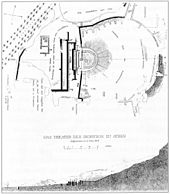Dionysus Theater
The Dionysostheater was the most important theater in ancient Greece and is considered the birthplace of the theater of ancient Greece and of drama in general. It is located on the southern slope of the Athens Acropolis . It got its name after Dionysus , the god of wine and ecstasy and madness . Him were in Athens every year in honor of Festival of Dionysia celebrated. This included theater performances that originally emerged from cultic song, dance and sacrificial rites and took place in the Dionysus Theater. The famous classical tragedies of Aeschylus , Sophocles and Euripides premiered at the Dionysia.
history
The Dionysostheater was part of the sanctuary of Dionysus south of the Acropolis, which also included a temple . The theater was originally built in the 5th century BC. Chr. Laid out as a sacred building. At first it consisted of an orchestra at ground level and a simple wooden skene . During this time, the audience had to sit on a natural slope. 410 BC Wooden rows of seats were built in BC. The stone structure that can be seen today was built around 330 BC. Built in BC. The wooden seats were replaced by stone ones. There was also a stone stage building and the orchestra was set in marble .
Around 1863 the theater was excavated by the Athens Archaeological Society and recorded and documented for the first time by the local architect Ernst Ziller .
The theater is to be restored for several million euros by around 2015, after previous security work was only pushed forward slowly due to lack of money.
architecture
The Dionysostheater had 78 rows of seats and offered space for 17,000 spectators. The first row of seats consisted of 67 marble seats reserved for special dignitaries. The auditorium, the cavea , was arranged in a semicircle around the orchestra on which the choir performed. In the middle of the orchestra stood an altar on which Dionysus sacrifices were made. The actors appeared on the stage, the proskenion . Behind it was the stage building, the Skene. The paraskenias on the sides of the skene had six Doric columns on the front . The design of the rows of seats is astonishingly sophisticated. The width of the ring-shaped aisles gradually widens outwards, the more spectators they have to absorb from the radial aisles.
literature
- Ernst Robert Fiechter : The Dionysus Theater in Athens (= Ancient Greek Theater Buildings, book 5–7, 9). 4 volumes. Kohlhammer, Stuttgart 1934-50.
- Wolfgang W. Wurster : The new investigations at the Dionysostheater in Athens . In: Architectura 9, 1979, pp. 58-76.
- Savas Gogos: The Dionysus Theater of Athens. Architectural shape and function . Phoibos, Vienna 2008, ISBN 978-3-85161-004-8 .
- critical reviews: Lorenz E. Baumer, In: Museum Helveticum . No. 66, 3, 2009, pp. 173-174; Hans Peter Isler , In: Gnomon . No. 83, 2011, pp. 186-187; Author's reply: Savas Gogos: The Theater of Epidaurus. With a contribution to the acoustics of the theater by Georgios Kampourakis. Phoibos-Verlag, Vienna 2011, ISBN 978-3-85161-051-2 , pp. 66–67, note 117.
- Scott Scullion: The Fifth-Century Theater of Dionysus. In: the same: Three Studies in Athenian Dramaturgy (= contributions to antiquity. Volume 25). 2nd Edition. Teubner, Leipzig 2011, pp. 3-66 (by Verlag Walter de Gruyter ).
- Christina Papastamati-von Moock: The Theater of Dionysus Eleuthereus in Athens: New Data and Observations on its 'Lycurgan' Phase. In: Eric Csapo, Hans Rupprecht Goette , J. Richard Green, Peter Wilson (Eds.): Greek Theater in the Fourth Century BC. De Gruyter, Berlin / Boston 2014, pp. 15–76 (accessed via De Gruyter Online).
Web links
- Athens, Dionysus Theater (Achaea) on the Theatrum.de site of the State Archeology Department Mainz
- The Dionysus Theater on postcards
Remarks
- ^ Journal of the Archaeological Society in Athens 11, 1863; The theater of Dionysus at Athens . Recorded and drawn by Ernst Ziller. Explanatory text by Leopold Julius . In: Zeitschrift für Bildende Kunst 13, 1878, pp. 193–204. 236-242.
Coordinates: 37 ° 58 ′ 13 ″ N , 23 ° 43 ′ 40 ″ E




